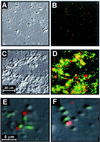Differentiation of chitinase-active and non-chitinase-active subpopulations of a marine bacterium during chitin degradation
- PMID: 10919822
- PMCID: PMC92186
- DOI: 10.1128/AEM.66.8.3566-3573.2000
Differentiation of chitinase-active and non-chitinase-active subpopulations of a marine bacterium during chitin degradation
Abstract
The ability of marine bacteria to adhere to detrital particulate organic matter and rapidly switch on metabolic genes in an effort to reproduce is an important response for bacterial survival in the pelagic marine environment. The goal of this investigation was to evaluate the relationship between chitinolytic gene expression and extracellular chitinase activity in individual cells of the marine bacterium Pseudoalteromonas sp. strain S91 attached to solid chitin. A green fluorescent protein reporter gene under the control of the chiA promoter was used to evaluate chiA gene expression, and a precipitating enzyme-linked fluorescent probe, ELF-97-N-acetyl-beta-D-glucosaminide, was used to evaluate extracellular chitinase activity among cells in the bacterial population. Evaluation of chiA expression and ELF-97 crystal location at the single-cell level revealed two physiologically distinct subpopulations of S91 on the chitin surface: one that was chitinase active and remained associated with the surface and another that was non-chitinase active and released daughter cells into the bulk aqueous phase. It is hypothesized that the surface-associated, non-chitinase-active population is utilizing chitin degradation products that were released by the adjacent chitinase-active population for cell replication and dissemination into the bulk aqueous phase.
Figures



References
-
- Alldredge A L, Youngbluth M. The significance of macroscopic aggregates (marine snow) as sites for heterotrophic bacterial production in the mesopelagic zone of the subtropical Atlantic. Deep Sea Res. 1985;32:1445–1456.
-
- Azam F. Microbial control of oceanic carbon flux: the plot thickens. Science. 1998;280:694–696.
-
- Azam F, Cho B C. Bacterial utilization of organic matter in the sea. In: Fletcher M, Gray T R G, Jones J G, editors. Ecology of microbial communities. New York, N.Y: Cambridge University Press; 1987. pp. 261–281.
-
- Bae H, Hudson S M. The cooperative binding behavior of sodium dodecyl sulfate to crosslinked chitosan films. J Appl Polymer Sci: Part A Polymer Chem. 1997;35:3755–3765.
Publication types
MeSH terms
Substances
Grants and funding
LinkOut - more resources
Full Text Sources

